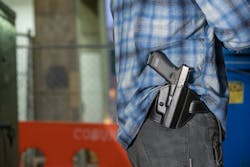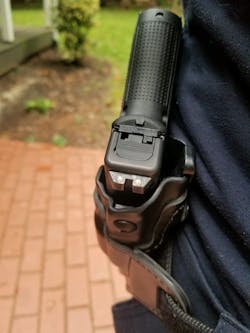Editor's Review: Safariland Model 637 ALS Holster
One challenge that used to exist pretty regularly was retention; specifically the lack thereof. Gravity is a beautiful thing, but it shouldn’t be the only thing holding your handgun in your holster. Part of being a law enforcement professional is recognizing that you will, most likely and at completely unexpected times, get into physical altercations. All of us have had to fight suspects into handcuffs. A gun that is held into a holster only by gravity might not stay in the holster during a wrestling match. More than one officer has gotten up off the ground after getting a suspect (finally) into handcuffs and looked down to see his sidearm laying on the sidewalk. That is a feeling like no other and one all of us would like to avoid—for the rest of our career and any time we’re carrying a sidearm thereafter.
A lot of holsters today provide “click in” retention by way of molded holster body. I’ve seen this done in leather and, far more often, with kydex. The problem is that one of the biggest reasons we want sidearm retention is to keep other people from being able to easily take our gun. Those “click in” retention holsters don’t do anything to keep a bad guy from snatching your gun. The gun and the holster don’t know the difference between you pulling it out and a bad guy pulling it out. I’m not saying there’s no place for those holsters, but a realistic understanding of their value where retention is concerned is necessary.
A good retention holster will incorporate some type of retention device that requires release or deactivation before the gun can be drawn from the holster. These Level II retention holsters also incorporate either the “click in” snug fit holster body or some type of adjustable friction retention device. Keeping all of that in mind, let’s take a look at the Safariland Model 637 ALS holster.
The 637ALS also has an adjustable tension screw so that the level of friction holding the gun into the holster can be customized to the individual owner/wearer. Both of these security features, the ALS and the tension screw, are part of the interior holster body which is made of a composite material (not kydex). That interior holster body is housed in a comfortable leather belt mounting outer that we all recognize. It looks like a fairly standard pancake holster without a thumb strap. The holster body is pliable and conforms to the wearer’s waist curve once the belt it tightened.
During wear testing, the 637ALS holster fit snug against the body and was comfortable to wear over the period of a day (12 to 16 hours, depending on the day). It was reasonably easy to conceal as it does fit fairly flat against the body and the slight curve required to house the gun looks like part of the body’s natural curve under a concealing garment. The butt of the weapon can print depending on how tight your cover garment is, but that’s not the holster’s fault.
During range testing, the holster proved relatively easy to draw from. The draw stroke/motion, once mastered for releasing the ALS system, is straight up out of the holster. Thanks to the composite holster interior body, the mouth of the holster stays open, making for pretty easy holstering as well.
For the purposes of testing this holster, it was worn daily for the better part of a month and concealed, most of the time, simply by a baggy t-shirt. On a couple of occasions, the weapon/holster was concealed under a sport coat and wasn’t noticed by folks and a few of them actually paid attention to see if they could identify it.
Editor’s Note: For more information about the Safariland Model 637 ALS, check out the information page for it on their website at Safariland.com/products/model-637-als-concealment-holster-model_637.

Lt. Frank Borelli (ret), Editorial Director | Editorial Director
Lt. Frank Borelli is the Editorial Director for the Officer Media Group. Frank brings 20+ years of writing and editing experience in addition to 40 years of law enforcement operations, administration and training experience to the team.
Frank has had numerous books published which are available on Amazon.com, BarnesAndNoble.com, and other major retail outlets.
If you have any comments or questions, you can contact him via email at [email protected].





